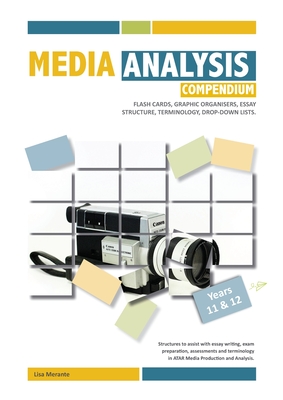Media Analysis Study Compendium

Media Analysis Study Compendium
Media Analysis Study Compendium provides upper school Media students with support in the form of flashcards, graphic organisers, terminology, sentence stems, drop-down lists, essay writing structures, and media theories to assist in being a successful Media student. Content includes: 1. PLAN TO SUCCEED: Establish sound study habits by setting goals, organising a revision timetable, recording when assessments are due, and knowing what and when to revise will help students to achieve success.2. CODES AND CONVENTIONS: Infographics are provided to visually highlight the symbolic, written, audio, and technical code components of media literacy. Additional graphics visually explain shot sizes and camera angles. Conventions associated with narrative construction, genre, film movements, documentaries, television, and editing are clearly laid out.3. FLASHCARDS: Flash cards containing Year 11 and 12 Media terminology and summarised, bullet-pointed essential content related to each term, are presented for students to study effectively.4. TERMINOLOGY: Students will find useful sentence stems showing ways to describe editing, camera shots, sound, camera movements, and more. Word banks, phrases, and sentence stems are organised according to common media terminology to assist students to use subject-specific terminology when analysing a media text. Command verbs used to start a question, such as analyse or discuss, are explained.5. ESSAY STRUCTURE: The T.E.E.L model of topic sentence, explain, example, and link to the question or next paragraph are explained using clear structures and samples. Templates and structure strips are provided using the model to assist students with writing clear, organised, structured essays.6. GRAPHIC ORGANISERS: Numerous graphic organisers are provided to assist students with their study; from flash cards designed to help learn terminology and core concepts, to scaffolded organisers which focus on codes, context, audience, values, ideologies, narrative, and representation.7. DROP-DOWN LISTS OF ESSENTIAL CONTENT: Extended study organisers containing detailed components, or drop-down lists, of key essential content to assist with assessments and exams.8. SUMMARIES OF MEDIA THEORIES: Major communication theories, narrative theories, representation theory, auteur theory, genre theory and identity theory are summarised to assist student learning.9. PRACTICE, ORGANISE, DE-STRESS: Space is provided to take notes and review Media terminolo
247.94Lei
247.94Lei
Indisponibil
Descrierea produsului
Media Analysis Study Compendium provides upper school Media students with support in the form of flashcards, graphic organisers, terminology, sentence stems, drop-down lists, essay writing structures, and media theories to assist in being a successful Media student. Content includes: 1. PLAN TO SUCCEED: Establish sound study habits by setting goals, organising a revision timetable, recording when assessments are due, and knowing what and when to revise will help students to achieve success.2. CODES AND CONVENTIONS: Infographics are provided to visually highlight the symbolic, written, audio, and technical code components of media literacy. Additional graphics visually explain shot sizes and camera angles. Conventions associated with narrative construction, genre, film movements, documentaries, television, and editing are clearly laid out.3. FLASHCARDS: Flash cards containing Year 11 and 12 Media terminology and summarised, bullet-pointed essential content related to each term, are presented for students to study effectively.4. TERMINOLOGY: Students will find useful sentence stems showing ways to describe editing, camera shots, sound, camera movements, and more. Word banks, phrases, and sentence stems are organised according to common media terminology to assist students to use subject-specific terminology when analysing a media text. Command verbs used to start a question, such as analyse or discuss, are explained.5. ESSAY STRUCTURE: The T.E.E.L model of topic sentence, explain, example, and link to the question or next paragraph are explained using clear structures and samples. Templates and structure strips are provided using the model to assist students with writing clear, organised, structured essays.6. GRAPHIC ORGANISERS: Numerous graphic organisers are provided to assist students with their study; from flash cards designed to help learn terminology and core concepts, to scaffolded organisers which focus on codes, context, audience, values, ideologies, narrative, and representation.7. DROP-DOWN LISTS OF ESSENTIAL CONTENT: Extended study organisers containing detailed components, or drop-down lists, of key essential content to assist with assessments and exams.8. SUMMARIES OF MEDIA THEORIES: Major communication theories, narrative theories, representation theory, auteur theory, genre theory and identity theory are summarised to assist student learning.9. PRACTICE, ORGANISE, DE-STRESS: Space is provided to take notes and review Media terminolo
Detaliile produsului










